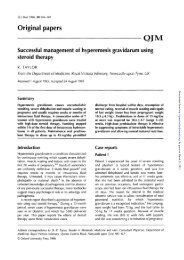Biochemical markers of alcohol abuse - QJM: An International ...
Biochemical markers of alcohol abuse - QJM: An International ...
Biochemical markers of alcohol abuse - QJM: An International ...
Create successful ePaper yourself
Turn your PDF publications into a flip-book with our unique Google optimized e-Paper software.
The measurement <strong>of</strong> GST did not <strong>of</strong>fer any further<br />
advantages over the other <strong>markers</strong>, and lacked sensit-<br />
ivity. Although not statistically significant, there was<br />
an impression that the NALD patients may have<br />
lower levels <strong>of</strong> elevation <strong>of</strong> GST and this would<br />
require further, intensive investigation.<br />
In conclusion, although the newer biochemical<br />
<strong>markers</strong> have good sensitivity in distinguishing<br />
excessive <strong>alcohol</strong> consumption from safer levels <strong>of</strong><br />
consumption, none, with the exception <strong>of</strong> mAST,<br />
appeared to <strong>of</strong>fer any benefit over established<br />
conventional tests (AST, GGT) in this study. None <strong>of</strong><br />
the <strong>markers</strong> <strong>of</strong>fered the possibility <strong>of</strong> clearly distinguishing<br />
between <strong>alcohol</strong>ism and NALD. mAST<br />
again appeared to be the best new marker in this<br />
respect, although the AST/ALT ratio was equally<br />
useful. Discriminant analysis demonstrated that by<br />
using only two <strong>markers</strong> (i.e. the logarithm <strong>of</strong> mAST<br />
and AST/ALT ratio) almost 90% <strong>of</strong> patients could be<br />
correctly classified into one <strong>of</strong> the two groups<br />
(<strong>alcohol</strong>ics or NALD). CDT displayed excellent sensitivity,<br />
but was also elevated in the NALD patients—<br />
this may have been due to the fact that almost 50%<br />
had primary biliary cirrhosis, which is known to be<br />
associated with increased CDT.<br />
We are aware that our study is based on interviews<br />
with patients, and only in six cases was the information<br />
obtained confirmed by speaking to a relative.<br />
There is therefore a distinct possibility that a proportion<br />
<strong>of</strong> the patients may not have given a true<br />
reflection <strong>of</strong> their drinking habits and practices. The<br />
results and findings <strong>of</strong> this study need to be explored<br />
in a much larger trial to assess the true value <strong>of</strong><br />
many <strong>of</strong> the newer potential <strong>markers</strong> <strong>of</strong> excessive<br />
<strong>alcohol</strong> consumption.<br />
Acknowledgements<br />
We thank the physicians <strong>of</strong> Belfast City Hospital for<br />
allowing us access to their patients, and Drs C.N.<br />
Moorehead (Shaftesbury Square Hospital) and<br />
M. Callender (Liver Clinic, Royal Victoria Hospital,<br />
Belfast) for their valued help in this study. We<br />
particularly thank Dr C. Patterson for his statistical<br />
advice, and Dr R Rej for his kind donation <strong>of</strong><br />
antibody directed against cytosolic AST.<br />
References<br />
1. Royal College <strong>of</strong> General Practitioners. Alcohol: A Balanced<br />
View. Royal College <strong>of</strong> General Practitioners, London,<br />
1986.<br />
2. Rosman AS, Lieber CS. Biological <strong>markers</strong> <strong>of</strong> <strong>alcohol</strong>ism. In<br />
CS Lieber, ed. Medical and nutritional complications <strong>of</strong><br />
<strong>alcohol</strong>ism. New York, Plenum, 1992.<br />
3. Whitehead TP, Clarke CA, Whitfield AGW. <strong>Biochemical</strong><br />
Markers <strong>of</strong> <strong>alcohol</strong> <strong>abuse</strong> 143<br />
and haematological <strong>markers</strong> <strong>of</strong> <strong>alcohol</strong> intake. Lancet 1978;<br />
1:978-81.<br />
4. Cushman P, Jacobsen C, Barboriak JJ. <strong>Biochemical</strong> <strong>markers</strong><br />
for <strong>alcohol</strong>ism: sensitivity problems. Alcoholism Clin Exp<br />
Res 1984; 8:253-7.<br />
5. Skinner HA, Holt S, Schuller R. Identification <strong>of</strong> <strong>alcohol</strong><br />
<strong>abuse</strong> using laboratory tests and a history <strong>of</strong> trauma. <strong>An</strong>n Int<br />
MecM984; 101:847-51.<br />
6. Salaspuro M. Characteristics <strong>of</strong> laboratory <strong>markers</strong> in<br />
<strong>alcohol</strong>-related organ damage. ScandJ Castroenteroh 989;<br />
24:769-80.<br />
7. Stibler H, Borg S, Joustra M. Micro-anion exchange<br />
chromatography <strong>of</strong> carbohydrate deficient transferrin in<br />
serum in relation to <strong>alcohol</strong> consumption. (Swedish Patent<br />
8400587-5). Alcoholism Clin Exp Res 1986; 10:535-44.<br />
8. Kapur A, Wild G, Milford-Ward A, Triger DR. Carbohydratedeficient<br />
transferrin: a marker for <strong>alcohol</strong> <strong>abuse</strong>. Br MedJ<br />
1989; 299:427-31.<br />
9. Behrens UJ, Worner TM, Braly LF, Schaffner F, Lieber CS.<br />
Carbohydrate-deficient transferrin, a marker for chronic<br />
<strong>alcohol</strong> consumption in different ethnic populations.<br />
Alcoholism Clin Exp Res 1988; 12:427-32.<br />
10. Xin Y, Lasker JM, Rosman AS, Lieber CS. Isoelectric<br />
focusing/Western blotting: A novel and practical method for<br />
quantitation <strong>of</strong> carbohydrate-deficient transferrin in<br />
<strong>alcohol</strong>ics. Alcoholism: Clin Exp Res 1991; 15:814-21.<br />
11. Morino Y, Kagamiyama H, Wada H. Immunochemical<br />
distinction between glutamic-oxaloacetic transaminases<br />
from the soluble and mitochondrial fractions <strong>of</strong> mammalian<br />
tissues. J Biol Chem 1964; 239:943-44.<br />
12. Ishii H, Okuno F, Shigeta Y, Tsuchiya M. Enhanced serum<br />
glutamic oxaloacetic transaminase activity <strong>of</strong> mitochondrial<br />
origin in chronic <strong>alcohol</strong>ics. In: Galanter M, ed. Currents in<br />
Alcoholism, vol. 5. New York, Grune and Stratton,<br />
1979:101-8.<br />
13. Nalpas B, Vassault A, Charpin S, Lacour B, Berthelot P.<br />
Serum mitochondrial aspartate aminotransferase as a marke<br />
<strong>of</strong> chronic <strong>alcohol</strong>ism: Diagnostic value and interpretation<br />
in a liver unit. Hepatology 1986; 6:608-14.<br />
14. Nalpas B, Poupon RE, Vassault A, Hauzanneau P, Sage Y,<br />
Shellenberg F, Lacour B, Berthelot P. Evaluation<br />
<strong>of</strong> mAST/tAST ratio as a marker <strong>of</strong> <strong>alcohol</strong> misuse in a nonselected<br />
population. Alcohol Alcoholism 1989; 24:415-19.<br />
15. Hiley C, ef al. The human glutathione-s-transferases:<br />
immunohistochemical studies <strong>of</strong> the development<br />
expression <strong>of</strong> alpha and pi-class isoenzymes. BiochemJ<br />
1988; 245:255-9.<br />
16. Beckett GJ, Chapman BJ, Dyson EH, Hayes JD. Plasma<br />
glutathione-s-transferase measurements after paracetamol<br />
overdose: evidence for early hepatocellular damage. Gut<br />
1985; 26:26-31.<br />
17. Beckett GJ, Foster GR, Hussey AJ, Oliveira DBG, et al.<br />
Plasma glutathione-s-transferase and F protein are more<br />
sensitive than alanine aminotransferase as <strong>markers</strong> <strong>of</strong><br />
paracetamol (acetaminophen) induced liver damage. Clin<br />
Chem 1989; 35:2186-9.<br />
18. Rej R. <strong>An</strong> immunochemical proceedure for determination <strong>of</strong><br />
mitochondrial aspartate aminotransferase in human serum.<br />
Clin Chem 1980; 26:1694-700.<br />
19. Bush B, Shaw S, Cleary P, Delbanco TL, Aronson MD.<br />
Screening for <strong>alcohol</strong> <strong>abuse</strong> using the CAGE questionnaire.<br />
Am J Med 1987; 82:231-5.<br />
20. Persson J, Magnusson PH. Comparison between different<br />
Downloaded from<br />
http://qjmed.oxfordjournals.org/ by guest on January 5, 2013



